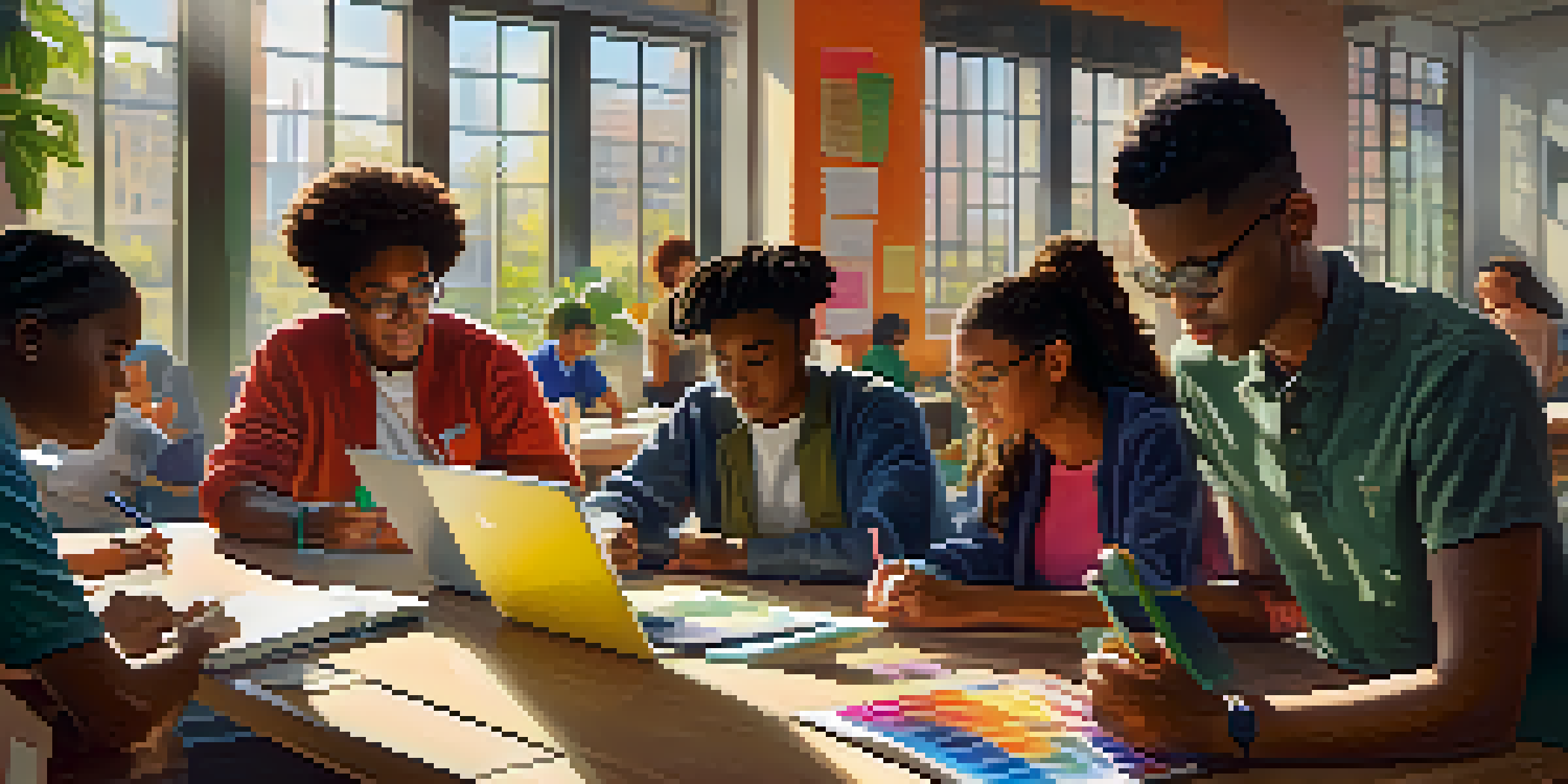Collaborative Learning and Its Role in Career Readiness Skills

Understanding Collaborative Learning in Education
Collaborative learning is an educational approach where students work together to achieve a common goal. This method emphasizes teamwork, communication, and problem-solving skills, making it not only effective for mastering content but also crucial for personal development. Through group projects, discussions, and peer reviews, learners can share diverse perspectives and insights, enriching their overall understanding.
Alone we can do so little; together we can do so much.
For instance, consider students working on a science project together. They might divide tasks based on individual strengths, which fosters a sense of responsibility and accountability. As they collaborate, they also learn to navigate disagreements and find common ground—skills that are invaluable in any workplace.
Ultimately, collaborative learning is about more than just academic success; it prepares students for the realities of the workforce, where collaboration is often key to innovation and productivity. By engaging with one another, students cultivate social and emotional skills that will serve them well in their careers.
The Importance of Soft Skills in Career Readiness
Soft skills, such as communication, teamwork, and adaptability, are increasingly recognized as essential for career readiness. Employers often prioritize these skills, as they contribute to a positive workplace culture and enhance overall productivity. In fact, many hiring managers believe that soft skills can be as important as technical skills in determining a candidate's success.

Consider a scenario where a team is tasked with developing a marketing strategy. The ability to listen actively, share ideas, and respond constructively to feedback can significantly impact the project's outcome. When students engage in collaborative learning, they inherently practice these soft skills, preparing them for similar challenges in their future jobs.
Collaborative Learning Enhances Skills
Working together in groups fosters essential skills like communication, teamwork, and critical thinking.
By honing their soft skills through collaboration, students not only improve their employability but also increase their confidence in navigating social dynamics in professional settings. This blend of competencies makes them more attractive to potential employers.
Building Critical Thinking Through Group Work
Critical thinking is another vital career readiness skill that can be developed through collaborative learning. When students work together, they encounter different viewpoints and challenge each other’s ideas, which fosters deeper analysis and evaluation of information. This interactive process encourages students to think critically about the problems they’re trying to solve.
Coming together is a beginning; keeping together is progress; working together is success.
For example, in a group tasked with analyzing a case study, members might question each other's assumptions, leading to a more comprehensive understanding of the issues at stake. This kind of dialogue not only sharpens their analytical skills but also promotes an environment where questioning and curiosity are valued.
As students learn to dissect arguments and construct well-reasoned conclusions, they are better equipped to handle complex situations in the workplace. The ability to think critically is prized in many fields, making collaborative learning a powerful tool for career advancement.
Enhancing Communication Skills Through Collaboration
Effective communication is the backbone of successful teamwork and a fundamental career readiness skill. In collaborative learning environments, students practice articulating their ideas clearly and listening to others, which helps them develop strong verbal and non-verbal communication skills. This ongoing practice is essential for building relationships in any professional setting.
Imagine a collaborative workshop where students must present their findings to the class. They must learn to convey their message effectively while also being receptive to questions and feedback. Such experiences not only enhance their public speaking abilities but also teach them the importance of adapting their communication style to different audiences.
Diversity Boosts Innovative Solutions
Diverse teams bring unique perspectives that lead to creative problem-solving and a more inclusive mindset.
By prioritizing communication in collaborative learning, students graduate with a toolkit of skills that prepare them for interviews, presentations, and teamwork in the workplace. These abilities increase their chances of success in their future careers.
The Role of Diversity in Collaborative Learning
Diversity within collaborative learning groups enriches the educational experience and prepares students for a global workforce. When students from various backgrounds come together, they bring unique perspectives that can lead to more innovative solutions. This exposure to diverse viewpoints is crucial in fostering an inclusive mindset, which is highly valued in today’s job market.
For instance, consider a team with members from different cultural backgrounds working on a project. They might approach problems in distinct ways, leading to creative solutions that wouldn't have emerged in a more homogenous group. This experience teaches students to appreciate diversity and leverage it as a strength.
Engaging in diverse collaborative settings not only broadens students' horizons but also equips them with the cultural competence needed to thrive in international workplaces. Such skills make them more adaptable and prepared for the complexities of global business.
Real-World Applications of Collaborative Learning Skills
The skills developed through collaborative learning extend far beyond the classroom; they are directly applicable in real-world job settings. Many industries require employees to work in teams on projects, and the ability to collaborate effectively can make all the difference. Students who engage in collaborative learning are often more prepared to hit the ground running in their careers.
For example, in the tech industry, developers often work in agile teams, where collaboration is essential for delivering projects on time. A student who has learned to work in a team setting is likely to adapt quickly to this environment, contributing to their team's success from day one.
Real-World Readiness from Collaboration
Skills learned through collaborative learning directly translate to workplace success, preparing students for team dynamics.
As students transition into the workforce, they will find that their collaborative experiences have equipped them with the tools needed to navigate team dynamics, manage conflicts, and drive projects forward. This preparedness can significantly boost their confidence and career trajectory.
Measuring the Impact of Collaborative Learning on Career Readiness
Evaluating the effectiveness of collaborative learning in fostering career readiness skills is essential for educators and institutions. By gathering feedback from students and employers, educators can gain insights into how well these skills translate into the workforce. This feedback loop allows for continuous improvement in teaching strategies and curriculum design.
For instance, surveys and interviews with graduates can provide valuable data on how collaborative learning experiences have impacted their job performance. If a significant number report feeling more prepared for teamwork and communication challenges, it underscores the value of these methods in education.

Ultimately, measuring the impact of collaborative learning can lead to more effective educational practices that align with industry expectations. By prioritizing this approach, institutions can ensure that graduates are well-equipped for the demands of their careers.